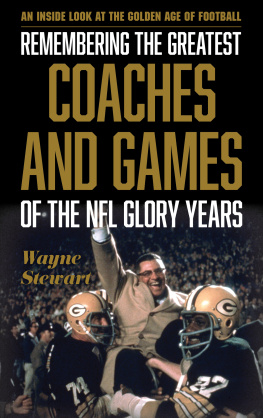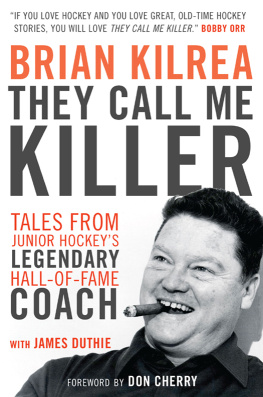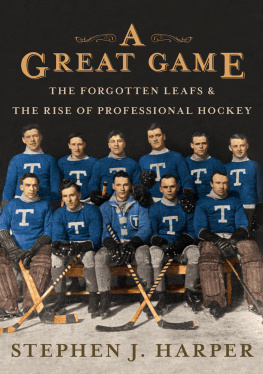 1
1
THE
TORTURED SOUL
TERRY SAWCHUK
I dont think Terry enjoyed his successes. Thats what happens when youre depressed; you dont have the capacity to enjoy what youve accomplished. I just never saw that joy in him.
Former Toronto Maple Leafs teammate RON ELLIS
NEAR THE END of the 196566 season, Terry Sawchuk appeared on the cover of Life magazine to promote a story called Hockey Goalies: Their Bludgeoned Faces and Bodies. In the photo, scars criss-cross his face like train tracks across the Great Plains. Looking into the distance, Sawchuk appears to be scowling at someoneperhaps the photographers assistantand sending a message to readers. With a curled lip, he seems to be saying, Go to hell!
Considered one of the best goalies ever to strap on the pads, Sawchuk was as unpleasant off the ice as he was brilliant on it. Haunted by personal demons and plagued by endless health problems, he was sullen and moody. Thanks to his ornery nature, often worsened by alcohol, he alienated his loved ones, his teammates and just about everyone else. In the end, he died much the way he livedmad as a hornet.
TERRY SAWCHUK grew up in a working-class neighborhood of Winnipeg, Manitoba, wedged between the Red River and the Canadian Pacific Railway tracks. His father, Louis, who had fled poverty in Ukraine, was known for his toughness. According to legend, he once settled an argument with a former Canadian boxing champion by knocking him out with a single punch. Louis didnt earn much money as a tinsmith, but it was enough to support his wife, Anne, and their five children.
Sawchuk was born in December 1929, the third of four sons. No sooner had he learned to walk than he was spending winter days racing across a backyard rink, chasing a piece of frozen horse dung that served as a puck. Encouraged by his older brother Mitch, he became a goaltender. Mitch, a goalie himself, taught his kid brother the importance of staying balanced and keeping his eye on the puck at all times.
In addition to sharing a passion for hockey, the brothers shared a bed in their modest family home. The arrangement served a dual purposeit saved space in cramped quarters, and the body heat it generated kept them from waking up as frozen as the horse dung so central to their lives.
Mitch died of a heart attack when he was just 17. His death devastated family members, none more than the brother who had been his constant companion. Louis and Anne, who had lost another son to scarlet fever when Terry was a baby, were too grief-stricken to comfort their remaining children. Left to cope with the pain on his own, Terry cried himself to sleep most nights and descended into a darkness from which he never fully emerged.
Yet his passion for sports continued. On his way to church one Sunday, Sawchuk came across a group of boys playing rugby. Instead of sitting in a pew for the next few hours, he spent that time exchanging bone-crushing blows with his new friends. He emerged from one pileup with a throbbing pain in his right elbow but didnt tell his parents for fear of being punished. The pain subsided over time, but the broken arm didnt heal properly. It ended up two inches shorter than his left arm and had limited range of motion. It troubled him for the rest of his life.
Sawchuk was a big, chubby kid when he started playing organized hockey, but his prodigious talent was evident right away. It caught the attention of Bob Kinnear, a midget-hockey coach and scout for the Detroit Red Wings. At his urging, the Red Wings invited Sawchuk to Detroit for an evaluation in 1944. The teenager impressed the Red Wings, and they kept an eye on him in the following months.
He was playing for the Junior A Winnipeg Monarchs in the 194546 season when the Chicago Blackhawks came calling. That prompted Detroit to spring into action. Kinnear visited the Sawchuk family home and convinced Terrys parents to put his career in the Red Wings hands.
The young goalie, who had dropped out of school to take a job as a sheet metal worker, soon headed to Galt, Ontario, (now part of Cambridge) to play for the Galt Red Wings of the Ontario Hockey Association. On his own for the first time, Sawchuk lived at a local rooming house.
The team joined the International Hockey League for the 194748 season and became the Windsor Spitfires. Sawchuk started in net but didnt stay long. Detroit, desperate to add an elite goalie to the mix, signed him to a professional contract. With the ink drying on the paper, a Red Wings executive handed the teenager a check for $2,000, the equivalent of $19,000 in 2013. For the tinsmiths son, it was a kings ransom.
The Red Wings sent him to the Omaha Knights of the United States Hockey League. He played in 54 games that season, winning 30 of them. He notched four shutouts and led the league with a 3.21 goals-against average. To absolutely no ones surprise, he was named the leagues top rookie.
Of course, the season wasnt without its dark periods. On his 18th birthday, he took a stick to the face during a goalmouth scramble, and it cut his right eye. With the dexterity of a wine-maker plucking a grape from a vine, a surgeon removed the goalies eye from its socket, stitched it up, popped it back in and sent him home wearing an eye patch. Much to everyones relief, Sawchuk didnt lose any vision and returned to the ice two weeks later.
Sawchuk headed east for the 194849 season, when he was promoted to the Indianapolis Capitols of the American Hockey League (AHL). He had another stellar season. He played in 67 games, collecting two shutouts and a 3.06 goals-against average. Sawchuk was named the AHLs best rookie.
In Indianapolis, Sawchuk refined his unique style. In the set position, he bent his knees in a crouch so low that his chin was almost resting on his goalie pads. It was an unorthodox stancegoalies stood straight up in those daysbut it allowed Sawchuk to maintain balance in various positions and to make quick lateral movements. Nestled behind his pads like an eagle in its nest, Sawchuk peered out at the ice and tracked the puck with relative easeeven as shots from the point and goalmouth traffic became more common. Effective though it was, the stance took a toll on his back; by the end of his career, Sawchuk walked with a permanent stoop and suffered from swayback, which prevented him from sleeping for more than two hours at a time.
NHL
194950
The 194950 season started off well for him, and then got better. In January, the Detroit Red Wings called him up to replace veteran Harry Lumley, who had suffered an ankle injury. In Sawchuks NHL debut, the Red Wings lost 43 to the Boston Bruins, thanks in part to Detroits defense corps, which accidentally put two pucks past their own goalie. Still, Sawchuk played well despite his nerves and stayed in net for the next six games. He gave up an average of just two goals a game and posted his first NHL shutout. When Lumley returned to good health, Sawchuk returned to Indianapolis. On the day the Red Wings won their first Stanley Cup in almost a decade, Sawchuk was gonebut not forgotten.
195051
Heading into the 195051 season, the Red Wings had some of the best young guns in the league: Gordie Howe, Ted Lindsay, Alex Delvecchio, Marcel Pronovost and Red Kelly. Jack Adams, the Red Wings general manager, put his faith in Sawchuk and sent Lumley to the Chicago Blackhawks.
Next page








 1
1
